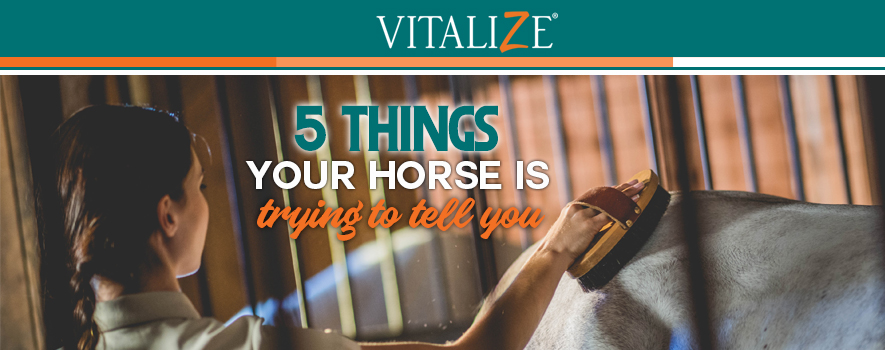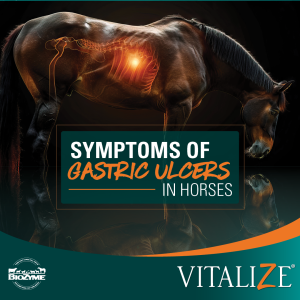Your horse is your best friend. You spend hours grooming, tacking, riding and caring for him or her. As with any best friend, you find yourself telling it everything. There’s only one small problem… it can’t speak back to you.
While some things are better left unsaid (like what your horse really thought about your last ride), other thoughts would be helpful if they were spoken, so we could better understand how the horse feels and what we can do to help. So as responsible horse owners, we must read between the lines to know what our four-legged friends are trying to tell us. Key physical behaviors often indicate certain ailments, injuries or problems. Let’s take a look at some common behaviors and what your horse is trying to tell you for each:
- Shivering of the back
What your horse is trying to tell you: “Ouch, my back hurts!”
While being brushed or touched on the back, your horse “shivers” its skin. Sometimes horses do this when they are ticklish. However, when it is particularly in the area behind their withers, they are most likely backsore. If your horse shows signs of being backsore, a simple solution may be changing your tack. If the fit of your saddle is not right, your horse may develop white rub marks where there is uneven distribution of pressure. Discuss with your trainer if you have questions about saddle fit and consult with your vet if the problem persists. Your vet may suggest you seek out specific treatments such as chiropractic, acupuncture, magnetic or hydro therapies as well, depending on the horse.
- Pawing, pacing, laying down, looking at their sides or going off feed
What your horse is trying to tell you: “My stomach hurts, and I might be colicking.”
The symptoms listed above are all tell-tale signs of a word no one likes to hear: colic. Should you notice one or a combination of these signs, contact your veterinarian immediately. Your vet will ask you to describe the situation and may give you instructions for what to do before he or she gets there. Although colic is scary, it is also important for you to know your horse’s normal routines, too. Some are chronic stall pacers or pawers, but this does not mean they are colicking every time they do this. Use your best judgement and always keep a tube of Vitalize® Equine Gel on hand to administer at the first signs of a possible colic. The prebiotic Amaferm® is research-proven to increase digestion and good microbes in the gut, which may help turn your horse around from a bad situation.
- Standing with front hooves stretched forward, strong digital pulse
What your horse is trying to tell you: “My feet hurt, and I might be foundering”
Foundering orlaminitis, is the inflammation of the laminae—the soft tissue that attaches the coffin bone of the foot to the hoof wall. This serious condition generally occurs when your horse has consumed too much starch or lush forage and the digestive system is overwhelmed, causing a drop in pH along with a release of harmful endotoxins into the bloodstream. If you notice your horse standing with its feet stretched out in front of it and suspect this condition, contact your veterinarian immediately
- Girthy, grumpy, poor performance or weight loss
What your horse is trying to tell you: “I am in pain, and I might have ulcers.”
Ulcers are a common concern for competition horses that travel and perform often and are subject to stress. It is proven up to 90% of performance horses suffer from gastric ulcers, lesions in the upper portion of the horse’s stomach. Although stress cannot be totally avoided in herd animals, we can do our best to minimize anxiety, feed concentrated meals in smaller portions throughout the day, and implement a research-backed supplement that is designed to aid and prevent these problems, such as Vitalize Alimend®.
- Lameness, walking on their toes, increased digital pulse, heat in the hoof
What your horse is trying to tell you: “I have an abscess.”
Abscessesare fairly common and are merely “zits,” or infections in the hoof. They work like a pimple and begin with bacteria getting into the hoof, creating a gradual increase in pressure, and eventually a pop. Although they need proper treatment, owners generally sound a sigh of relief once they are told it is just an abscess, since symptoms of an abscess closely mirror those of other serious lamenesses, such as a suspensory injury, which takes months to years to heal rather than a few days. It is important to have your farrier out immediately to assess whether you are dealing with an abscess or something more serious that requires a veterinarian. When diagnosed with an abscess, your horse will need to soak its hoof in Epsom salt to draw out the infection and cause it to burst. Once ruptured, proper hoof care including daily maintenance and correct farrier work is needed to help your horse prevent future abscesses from occurring.
We all wish our horses could speak to us, but since they can’t, it is up to us to figure out what they are trying to communicate. Knowing these common signs, observing your horse’s normal behaviors and keeping a close eye on your surroundings while at the barn will help protect your horses from the above problems. To help your horse deal with the internal impacts of stress and maintain a balanced microbe population in the gut, consider adding Vitalize to their diet.



